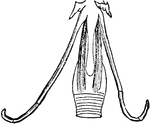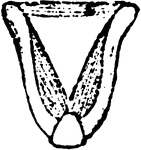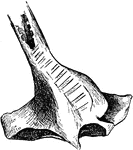
The Bony Labyrinth of a Sea Duck
"Bony labyrinth at the bottom of the trachea of the male Clangula islandica, seen from behind." Elliot…
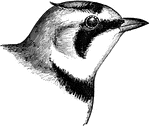
Shore Lark
"Shore Lark or Horned Lark. Upper parts in general pinkish-brown, this pinkish or vinaceous or liliaceous…

Shore Lark
"Shore Lark or Horned Lark. Upper parts in general pinkish-brown, this pinkish or vinaceous or liliaceous…

The Laryngeal Muscles of a Rook
"a, b, c, d, inferior laryngeal or syringeal muscles, not well made out in this figure; But typical…

The Larynx Muscles of a Rook
"Muscles of the larynx. thyro-arytenoids, or openers of the glottis" Elliot Coues, 1884
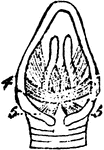
The Larynx Muscles of a Rook
"Muscles of the larynx. Thyro-cricoids, posterior thyro-cricoids." Elliot Coues, 1884

The Larynx of a Rook
"Larynx viewed from before (below); a, thyroid bone or cartilage." Elliot Coues, 1884

The Larynx of a Rook
"Larynx viewed from behind (above); a, thyroid bone; b, b, its appendages; c, cricoid; d, d, arytenoids;…

The Larynx of a Rook
"Larynx viewed from the right side; a, thyroid; b, appendage; c, cricoid; d, arytenoid; f, f, cartilage…
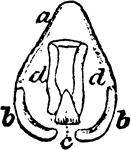
The Larynx of a Rook
"Larynx viewed from behind; a, thyroid; b, b, its appendages; c, cricoid; d, d, arytenoid." Elliot Coues,…
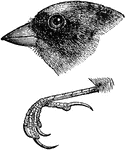
Red-poll Linnets
"Bill small, short, straight, very acute, more or less compressed, the lateral outlines usually a little…

Black-breasted Longspur
"Rhynchophanes maccowni. Black-breasted Longspur. Bay-winged Longspur. Upper parts slate-gray, streaked…
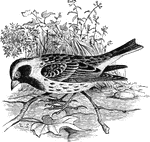
Lapland Longspur
"Centrophanes lapponicus. Lapland Longspur. Whole head, throat and breast jet-black, bordered with buffy…

Common Loon
"Colymbus torquatus. Common Loon. Great Northern Diver. Adult: Bill black, the tip and cutting edges…
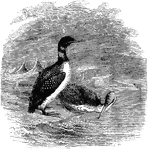
Loons
"Colymbus torquatus. Common Loon. Great Northern Diver. Adult: Bill black, the tip and cutting edges…

A Magpie Sitting on a Tree Branch Looking Down While Surrounded by Other Trees
"The Pica rustica, or Magpie, extends through the Palaearctic Region, and reaches Formosa and North…

magpie
"Pica. rustica hudsonica. Lustrous black, with green, purple, violet, and even golden iridescence, especially…
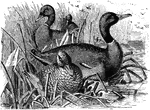
Mallards
"Anus boscas. Mallard. Wild or Domestic Duck. Green-head. Bill greenish-yellow. Feet orange-red. Iris…
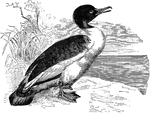
Merganser
"Mergus merganser. Merganser. Goosander. Nostrils near middle of bill. Frontal feathers extending acutely…

Red-breasted Merganser
"Mergus serrator. Red-breasted Merganser. Nostrils near base of bill. Frontal feathers extending obtusely…
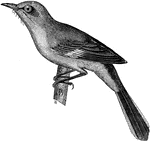
Mockingbird
"Mocking-Birds. Bill much shorter than head, scarcely curved as a whole, but with gently-curved commissure,…

Japanese Murrelet Bill
"Synthliborhamphus umizusume. Japanese Murrelet. Temminck's Auk. Bill more elongate and acute than in…
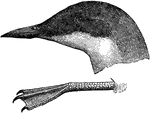
Craveri's Murrelet
"Brachyrhamphus craverii. Craveri's Murrelet. Entire upper parts unvararied cinereous, slightly darker…
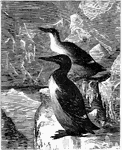
Murres
"Lomvia troile. Common Guillemot, or Murre. Adult in summer: Head and neck all around rich dark maroon…

Large Night-hawk
"Chordediles poptue. Night-hawk. Bull-bat. Above, mottled with black, brown, gray and tawny, the former…

Small Night-hawk
"Chordediles poptue. Night-hawk. Bull-bat. Above, mottled with black, brown, gray and tawny, the former…

American Nutcracker
"Picicorvus. American Nutcracker. General characteristics of the European Nucifraga. Bill slenderer,…
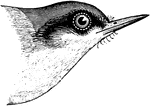
Brown-headed Nuthatch
"No black cap or white stripe on head. Upper parts dull ashy-blue; under parts sordid or muddy whitish.…

Red-breasted Nuthatch
"Upper parts leaden-blue the central tail-feathers the same; wings fuscous, with slight ashy edgings…
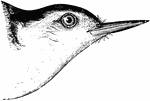
White-Breasted Nuthatch
"Upper parts, central tail-feathers, and much edging of the wings, clear ashy-blue; whole crown, nape,…

Female Uro-genital Organ
"Uro-genital organs of female embryo bird; from Owen, after Muller. a, kidneys: b, wolffian bodies;…

Male Uro-genital Organ
"Uro-genital organs of male embryo bird; from Owen, after Muller. a, kidneys: b, ureters; c, wolffian…

Female Uro-genital Organ
"Uro-genital organs of female embryo bird; from Owen, after Muller. a, testis; b, epididymis; c, sperm-duct…

Female Fowl Organs
"Female organs of domestic fowl, in activity; from Owen, after Carus. a, b, c, d, mass of ovarian ova,…
The Respiratory and Vocal Organs of a Rook
"Resipratory and vocal organs of the Rook, Corvus frugilegusm an Oscine Passerine bird; 1 a, tongue;…
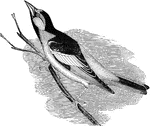
Bullock's Oriole
"Icterus bullocki. Bullock's Oriole. Adult male: Similarly black and orange, the orange invading the…

Osprey
An Osprey catching a fish. "Pandion haliaetus. Fish Hawk. Osprey. Adult. dark vandyke- brown, blackening…

The Skull Structure of an Ostrich
"Dromaeognathous skull of ostrich, nat. size specimen no. 16,629, U.S. Nat Museum, by Dr. R. W. Shufeldt,…

Ovenbird
"Golden-crowned Wagtail Warbler. Golden-crowned Accentor. Golden-crowned Thrush. Oven-bird. Seiurus…

Fowl Ovum
"Meroblastic ovum (yelk) of domestic fowl, bat. size, in section; after haeckel. a, the thin yelk-skin,…
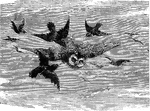
The Mobbing of an Owl
An adult owl being mobbed by a group of smaller birds. Mobbing occurs when smaller birds, in fear, will…

Barred Owl
"Strix nebulosa. Barred Owl. Hoot Owl. American Wood Owl. Toes fully feathered, nearly or quite to the…
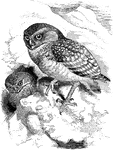
Two Burrowing Owls by the Mountains
"Speotyto cunicularia, the Burrowing Owl, a comparatively long-legged and short -winged bird with incomplete…

Burrowing Owl
"Speotyto cunicularia hypogae'a. Burrowing Owl. Adult: Above, dull grayish-brown, profusely spotted…
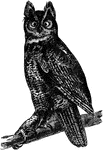
Great Horned Owl
"Bubo virginianus. Great Horned Owl. Hoot Owl. Cat Owl. Distinguished by its large size and conspicuous…
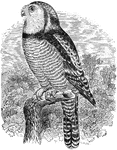
Hawk Owl
"Surnia funerea. American Hawk Owl. Day Owl. Bill and eyes yellow; claws brownish-black. Upper parts…
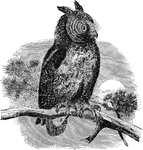
Screech Owl
Scops. Little Horned Owls. Screech Owls. Like the miniature Bubo in form (all our species under a foot…
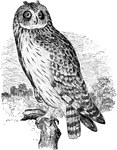
Short-eared Owl
"Asio accipitrinus. Short-eared Owl. Marsh Owl. Ear-tufts inconspicuous, much shorter than middle toe…
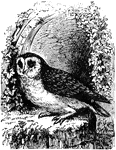
Small Barn Owls
"Aluco flammeus pratincola. Barn Owl. above, including upper surfaces of wings and tail, tawny, fulvous,…
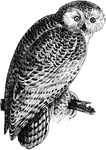
Snowy Owl
"Nyctea scandiaca. Snowy Owl. Pure white, spotted and barred with brownish-black markings, wholly indeterminate…
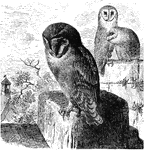
Barn Owls
"Aluco flammeus pratincola. Barn Owl. above, including upper surfaces of wings and tail, tawny, fulvous,…
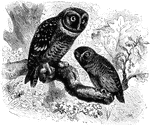
Saw-whet and Sparrow Owls
"Nyctala - Saw-whet Owls. Skull and ear-parts highly unsymmetrical, the the latter of great size, and…
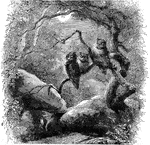
Screech Owls
"Scops. Little Horned Owls. Screech Owls. Like the miniature Bubo in form (all our species under a foot…

Oyster-catcher Bill
"Haematopus. Oyster-catcher. Bill peculiar - longer than tarsus, twice as long as head, constricted…
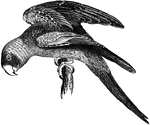
Carolina Parroquet
"Conuropsis carolinensis. Carolina Parroquet. Green; head yellow; face red; bill white; feet flesh-color;…

Carolina Parroquets
"Conuropsis carolinensis. Carolina Parroquet. Green; head yellow; face red; bill white; feet flesh-color;…
